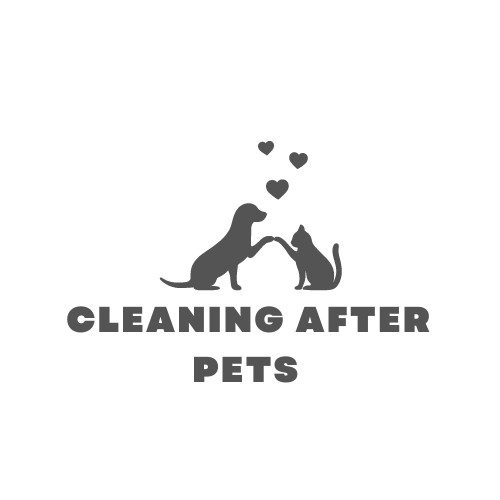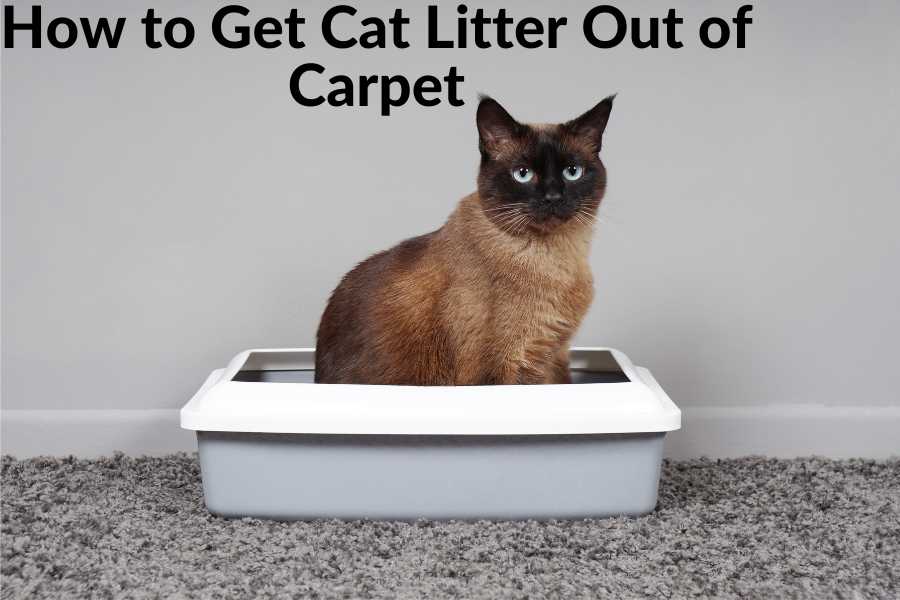As a cat owner, you know that cleaning up cat litter is part of your daily routine. However, sometimes cat litter spills or gets stuck in carpets, making it harder to clean up. If you’re wondering how to get cat litter out of carpets, don’t worry!
In this article, we’ll provide you with a step-by-step guide on how to get cat litter out of the carpet and prevent it from happening in the future.
Why Does My Cat Track Or Throw Litter Everywhere?

There is no one particular cause of cat litter transferring from the litter box to your carpet. It’s a combination of many different factors.
However, the most significant percentage of litter particles you find on your carpet results from tracking. Whenever your cat’s paws step on the litter, some litter will embed in its paws.
Since they don’t think much about the particles under their paws, they’ll walk away from the litter box without dusting their feet. As soon as they walk on the carpet, the carpet fibers wipe the particles off the paws and trap them, soiling your carpet.
In the same light, your cat’s hair (especially cats with long hair) is notorious for transferring litter from the box to your carpet. As they use the litter box, the litter embeds itself in their hair. The litter transfers from your cat’s body onto your carpet when they lie on your carpet or rugs.
Learn How To Clean Cat Poop And Get Rid Of Cat Poo Smell From Carpets
Sometimes, the litter may wind up on your carpet from your cat’s accidental or deliberate effort. For instance, cats are wired to try burying their poop after finishing their business. If you’ve set the litter box close to your carpet and the litter is small, open, or has low sides, your cat might kick the litter while barring their poop.
In other cases, your cat might kick the litter from the litter box to express dissatisfaction with the litter, especially when the litter has an unappealing texture and/or smell.
Understanding how your cat transfers their litter from the litter box to your carpet, you can take preemptive steps to negate the rate and amount of cat litter transferred onto your carpet, as you’ll see in the sections below.
Preparations For Cleaning Up Cat Litter On Carpet
You must prepare well to clean up cat litter on carpets. To this end, cleaning up the loose bits first is essential before we get into the nitty-gritty of removing cat litter from carpets. You can do this by following these simple steps:
- Use a dustpan and brush to pick up as much cat litter as possible. Be careful not to grind it further into the carpet fibers.
- Use a vacuum cleaner to suck up any remaining cat litter. Make sure to use the hose attachment to get into tight spaces.
- If you don’t have a vacuum cleaner, you can use manual cleaning methods. Sweep the debris into a dustpan and dispose of it.
You can also use sticky tape, such as duct tape or masking tape, to pick up the litter particles. Press the tape onto the litter and lift it away.
Finally, you can use a lint roller. This method is handy for cleaning small areas.
How To Get Cat Litter Out Of Carpet
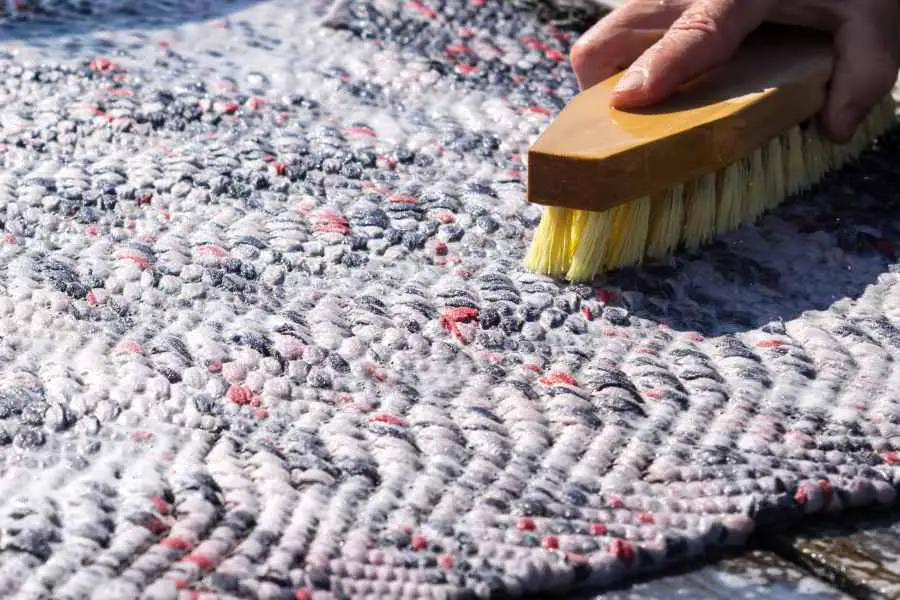
As cat owners, we love the companionship of our pets. However, cleaning up after the cat’s mess, such as getting car litter out of carpets, is a dreaded chore, especially if you have no clue how best to deal with it. Below, we’ll delve into the different ways you can deal with cat litter when your kitties track the litter onto your carpets.
How To Remove Dry Cat Litter From Carpets
If cat litter has been left on your carpet for a while, removing it can be challenging. Here are some ways to get dried cat litter out of the carpet:
Step #1: Broom Sweeping – Use a broom to sweep up the cat litter. Sweep the loose debris into a dustpan and dispose of it.
Step #2: Squeegee Sweeping – While your main goal is to clean up the litter, you might want to first remove any cat fur or loose carpet yarn from the affected area. Removing the car fur from the area negates the chances of the vacuum cleaner wand sucking up and clogging with cat fur.
Additionally, the squeegee ruffles up the loose litter particles, making it easier for the vacuum cleaner to suck it up.
Step #3: Dry Scrub – Dry scrub the cat litter to break the particles into smaller, more manageable pieces that your vacuum cleaner can readily suck up. For this step, use a hard-bristled brush. Work the brush gently over the litter to separate the litter from the carpet yarn.
Step #4: Vacuuming – Use a vacuum cleaner to suck up as much cat litter as possible. Make sure to use the hose attachment to get into tight spaces. If possible, use a short hose if you have one and if the circumstances allow for better suction.
Step #5: Clean The Remaining Residue With A Cleaner – Apply a carpet or enzymatic cleaner to the area and let it sit for a few minutes. Follow the instructions on the label for the best results. A carpet-safe, odor-neutralizing enzymatic cleaner is the preferred cleaning option. It can disintegrate any remaining urine from the litter and neutralize the odor.
Ensure you follow the user guidelines of the enzymatic cleaner you use.
NOTE: Spot-test the enzymatic cleaner on an inconspicuous part of your carpet to ensure it does not adversely affect the color or material of your carpet.
How To Remove Wet and Or Clumped Cat Litter From Carpets
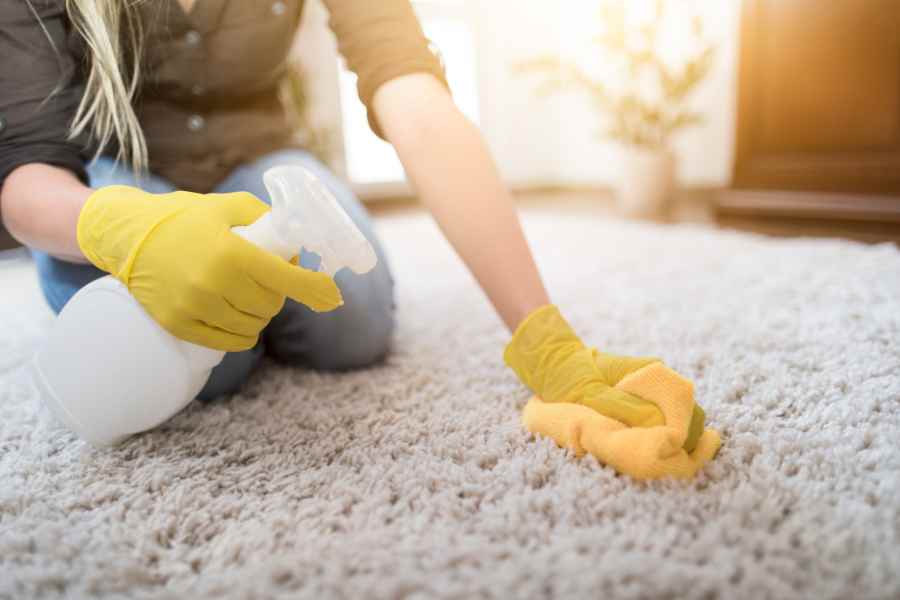
If the cat litter is wet and clumped together, you can try these methods:
Step #1: Scoop with a Shovel – In case you’re dealing with a lot of cat litter, the first step is to scoop as much as possible. For instance, if the litter box has tripped and fallen over, spilling its contents on your carpet, you should use a scoop or shovel to pick up the litter and place it in a garbage bag for disposal.
Step #2: Blotting with a towel – Use a clean towel or paper towel to blot up as much of the wet cat litter as possible. Don’t rub or scrub the area, as this can cause the stain to spread.
Step #3: Wait for the Litter to Dry – As any experienced cat owner will tell you, cleaning dry poop is a lot easier than wet poop. It is the same when dealing with cat litter. Dry cat litter is much easier to deal with than damp litter, so you must wait.
Once dry, you’ll deal with particles instead and a slimy mass of cat litter. Alternatively, you can point a fan at the wet litter to accelerate the drying process.
Step #4: Sweep and then dry Scrub – As shown in our cleaning dry cat litter section above, use a broom to sweep large chunks of the cat litter first. Squeegee clean the affected area to pick up loose fur or linen from the site. Finally, use a stiff-bristled brush to loosen the dry litter.
Step #5: Vacuum – After scrubbing with a brush, you’ll end up with cat litter particles. Vacuum up all the resulting debris. You can repeat the scrubbing and vacuuming processes to reduce matted debris if you notice some matted debris on your carpet.
Step #6: Using a Carpet Cleaner or Enzymatic Cleaner – After vacuuming the litter, utilize an industrial carpet cleaner and/or enzymatic cleaner to dissolve any remaining urine residue from the fibers. Always spot clean with a carpet cleaner or enzymatic cleaner to ensure your carpet will not be affected.
Cat litter tends to clump together after being exposed to urine or excrement. The longer the liter stays unchanged, the more clumping you can expect. Consider creating a daily routine of cleaning your cat’s litter box to avoid litter clumping.
Learn The Process, Tips And Tricks For Removing Cat Litter From Laminate Flooring
How To Remove Clay Cat Litter From Carpets
Clay cat litter is one of the most common types of cat litter and can be difficult to remove from carpets. If the cat litter is made of clay, you can try these methods:
Stepp #1: Using a wet-dry vacuum like the Hoover CleanSlate Plus Carpet – Use a wet-dry vacuum to suck up the cat litter. Follow the instructions on the vacuum cleaner for the best results.
Step #2: Applying a baking soda solution – Mix equal parts of baking soda and water to create a paste. Apply the paste to the affected area and let it sit for a few minutes. Use a clean cloth to wipe away the paste.
Step #3: Brushing – Use a stiff-bristled brush to loosen any remaining clay cat litter from the carpet fibers.
Step #4: Applying baking soda and Vacuuming – Sprinkle a generous amount of baking soda on the affected area and leave it for a few hours or overnight. Baking soda is an excellent odor absorbent, and it can help remove any lingering smells from the carpet.
After allowing the baking soda to sit, vacuum the area thoroughly to remove the baking soda and any remaining litter particles.
Step #5: Clean the Affected – Finally, consider using an industrial carpet cleaner or enzyme cleaner. Either of these cleaning solutions (or both) ensures your carpet is free of even the smallest molecules of urine that can kick off a foul smell.
Learn How To Clean Cat Litter And Litter Dust Off Hardwood Flooring
How To Dissolve Cat Litter From Carpets
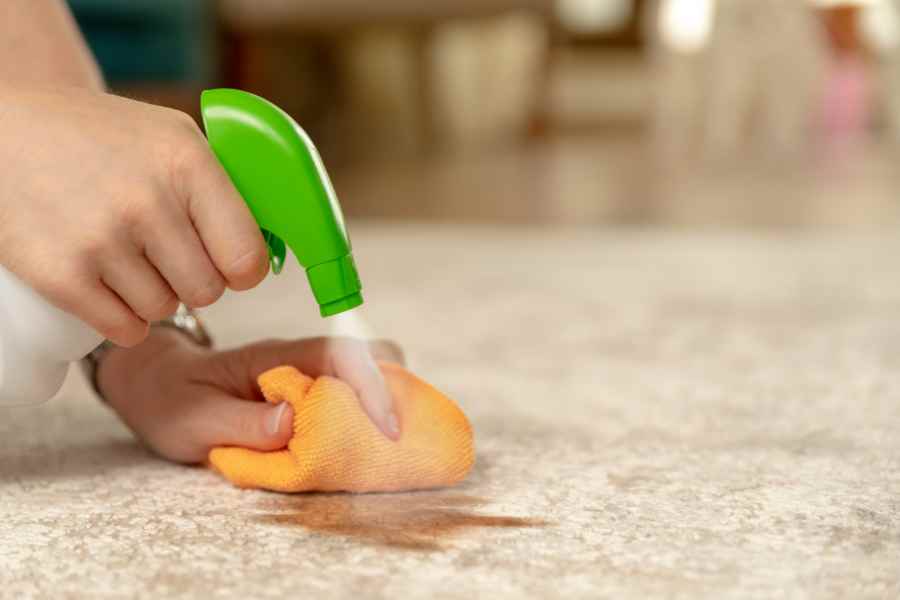
It’s difficult, if not impossible, to dissolve cat litter from carpets. Most litter materials are not soluble in water or other cleaning materials. Hence, the litter will not dissolve and form a liquid.
The next best alternative to dissolving cat litter is to disintegrate the chunks of clumping litter into smaller pieces of debris that you can eliminate from the carpet using the other cleaning methods in this article.
If the cat litter is stuck to the carpet fibers, you can try these methods:
Step #1: Using a vinegar solution – Mix equal parts of white vinegar and water in a spray bottle. Spray the solution on the affected area and let it sit for a few minutes. Use a clean cloth to blot up the solution.
Step #2: Steam Treatment – Steam treating the affected area helps to loosen and accelerate the disintegration of the stubborn litter residue. Any steam cleaner will suffice. If you don’t have a steam cleaner, you can use steam from your iron or kettle to loosen any residue that clings to the carpet fiber.
Step #3: Rinse with water – After using a cleaning solution, rinse the area and blot it dry with a clean towel.
How To Remove Hardened Cat Litter From Carpets
If the cat litter has been left on your carpet for a while, it can dry out, harden, and become difficult to remove. Here’s how to get hard cat litter out of carpets:
Step #1: Scraping – Use a plastic scraper or credit card-sized plastic to scrape away as much of the hardened cat litter as possible.
Step #2: Applying a cleaning solution – Once you have scraped away as much of the hardened cat litter as possible, the next step is to apply a cleaning solution to the affected area. You can use a homemade solution or a commercial cleaning product.
Step #3: Clean with Your Homemade Solution – One effective homemade solution is a mixture of white vinegar and water. Mix equal parts of water and white vinegar in a spray bottle and apply it to the hardened cat litter stain.
Allow the solution to sit for 5-10 minutes, then blot it with a clean cloth or sponge. Repeat the process until the stain is gone.
If you prefer a commercial cleaning product, look for one specifically designed for removing pet stains and odors. Follow the instructions on the product label and use them as directed.
Be sure to test the product on a small, inconspicuous area of the carpet first to ensure it doesn’t damage the carpet fibers or cause discoloration.
If the hardened cat litter stain persists after cleaning, consider hiring a professional carpet cleaning service. They have specialized equipment and expertise to remove tough stains and leave your carpet looking like new.
How To Clean Cat Litter On Wet Carpet
Kitty litter on wet carpets is a challenge to deal with. For starters, the dump conditions of the carpet or rug encourage the litter to soak in deeper and spread even further.
Step #1: Shovel as much Litter as Possible Without Spreading It – Using a litter shovel, pick as much litter as possible, being mindful not to spread the litter.
Step #2: Sprinkle Baking Powder over the Litter Mess – Sprinkle an ample amount of baking powder to cover the soiled section of the carpet. The baking soda will act as a deodorizing agent, reducing the risk of cat urine odor spreading over your wet carpet.
Step #3: Wait for the Litter to Dry – Working on the carpet after drying is much easier than when wet.
Step #4: Use a Dehumidifier like the homeLabs Dehumidifier to Accelerate the Drying Process – Place a dehumidifier in the room to accelerate the carpet drying process. In the case of an area rug, you can lay it somewhere outside to air dry if the weather permits.
Step #5: Remove as much of the Baking Soda and Cat Litter as possible – Once dry, scoop out as much of the dry baking soda and cat litter as possible. You can vacuum the affected area for this part of the process.
Step #6: Sweep And Dry Scrub – Dry the mass of dry baking soda and cat litter to break it down into smaller particles.
Step #7: Vacuum – Vacuum the area to remove the remaining baking soda particles and cat litter.
Step #8: Clean the affected area with a Carpet Cleaner and Enzyme Cleaner – Use carpet cleaner to clean the affected area. If you notice residue urine odor, consider cleaning the section with an enzyme cleaner.
Additionally, the moisture ensures the litter clumps together. Nonetheless, you can deal with litter on the wet carpet in the following way:
How To Remove Cat Litter Stains From Carpets

After cleaning up the cat litter, there are two main processes for removing any visible stains left on the carpet. It’s essential to note that if left uncleaned, the cat litter may leave behind unsightly and unpleasant stains on the carpet that can be difficult to remove in the future.
Using a carpet cleaner
Using a carpet cleaner is the most effective way to deal with large-scale stains left behind by cat litter.
Step #1: Vacuum the affected area to remove any loose debris – Before using the carpet cleaner, it’s essential to vacuum the affected area to remove any loose debris that may be present.
Step #2: Fill the carpet cleaner with water and cleaning detergent – Carpet cleaners typically require a water and cleaning solution mixture to be added to the machine before use.
Step #3: Run the carpet cleaner over the stained area – Once the machine is prepared, run it over the stained area to remove any remaining dirt or stains.
Ste #4: Allow the carpet to air dry completely before using the area – After cleaning with the carpet cleaner, it’s crucial to allow the carpet to air dry completely before using the site to prevent any damage or mold growth. You can point a fan on the affected area to accelerate the drying process.
Using a stain remover
This method is most effective when dealing with small-scale litter stains.
Step #1: Choose a stain remover that is safe to use on carpets and specifically designed to remove pet stains – It’s essential to choose a stain remover that is specifically designed for pet stains and safe to use on carpets to prevent any damage or discoloration.
Step #2: Apply the stain remover to the stained area – Once you have chosen a stain remover, apply it directly to the stained area.
Step #3: Allow the stain remover to sit for a few minutes – It’s essential to allow the stain remover to sit for a few minutes to allow it to penetrate the stain and work effectively to break down cat litter from your carpet.
Step #4: Blot the area with a clean cloth until the stain is removed – After the stain remover has sat for a few minutes, blot the area with a clean cloth until the stain is removed. Do not rub the stain; doing so will only help the stain to spread.
Ste #5: Repeat the process as necessary – Depending on the severity of the stain, it may be required to repeat the stain removal process multiple times until the stain is completely removed.
NOTE: There are numerous stain removers on the market. Ensure your stain remover of choice is not solvent-based. While solvents might remove stains from carpets and rugs, they also attack the latex that adheres the carpet yarn and backing together.
How To Prevent Cat Litter From Sticking To Carpet
Cat litter tracking on carpeted floors can be frustrating and time-consuming for many cat owners. Not only is it unsightly, but it can also be a hassle to clean up. Fortunately, there are several ways to prevent cat litter from sticking to the carpet and to minimize tracking.

Here are some tips for preventing your cat from tracking litter everywhere:
Use a Litter Mat – A litter mat is a great way to trap excess litter before spreading it throughout your home. Place the litter mat in front of the litter box and encourage your cat to step on it when exiting the box. The rug will catch stray litter particles and prevent them from sticking to the carpet.
Choose the Right Litter Box or Litter Robot – A litter box with a high sidewall or, better yet, an enclosed cat litter box such as a cat litter Booda dome will negate the risk of your cat tracking the debris from the box to your carpet as it prepares to use the container.
Additionally, the high side wall or enclosure reduces the risk of tracking the litter from the box to your carpet after they’re done using the litter box.
A DIY cat litter box we are sure works is to use a big Rubbermaid bin with an entry hole at the center of the lid.
Fill the box with up to 4 inches of litter. The box is large enough to reduce the risk of cats throwing litter on the floor/carpet as they cover their poop. With a lid covering the box, you can also negate tracking.
To get your cats used to a Rubbermaid bin, leave the box uncovered for 3 to 5 days before placing the lid over the box.
A bonus of using this DIY litter box is reduced odor and reduced maintenance requirements (you can get away with disinfecting and deodorizing the box once a month).
Use the Right Litter – Choosing the suitable litter can make all the difference in preventing litter tracking on the carpet. Some types of waste are more prone to sticking to carpet than others. For example, clay-based litters tend to be heavier and more likely to stick, while lighter litters, such as recycled paper, wood pellets, or soy pellet type, are less likely to stick and track.
Place Litter Boxes in Appropriate Areas – Another way to prevent litter tracking is to place the litter box in an appropriate area. Avoid placing the litter box near high-traffic areas or areas with carpeting. Instead, place the litter box in a quieter, less-used area of the house, such as a spare room or laundry room with non-carpeted flooring.
Lay a beach towel under the litter box – As your cat jumps out of the litter box onto the towel, it leaves the litter there.
Your Might Be Interested In Learning How Clean Litter Boxes And Trays
How To Get Cat Litter Smell Out Of Carpet
Even after you’ve removed the cat litter from the carpet, you may still be left with a lingering smell. Here are some ways to get rid of the odor:
OPTION 1: Baking soda – Sprinkle a generous amount of baking soda on the affected area and leave it for a few hours or overnight. Baking soda is a natural deodorizer that can help neutralize any lingering smells.
OPTION 2: Vinegar and water solution – Mix equal parts of white vinegar and water in a spray bottle. Spray the solution onto the affected area, but do not saturate the carpet. Blot the area with a clean cloth to remove excess moisture.
OPTION 3: Enzyme cleaner – Use an enzyme cleaner specifically designed for pet odors. Enzyme cleaners break down the molecules that cause the odor, eliminating the smell.
Can You Vacuum Cat Litter?
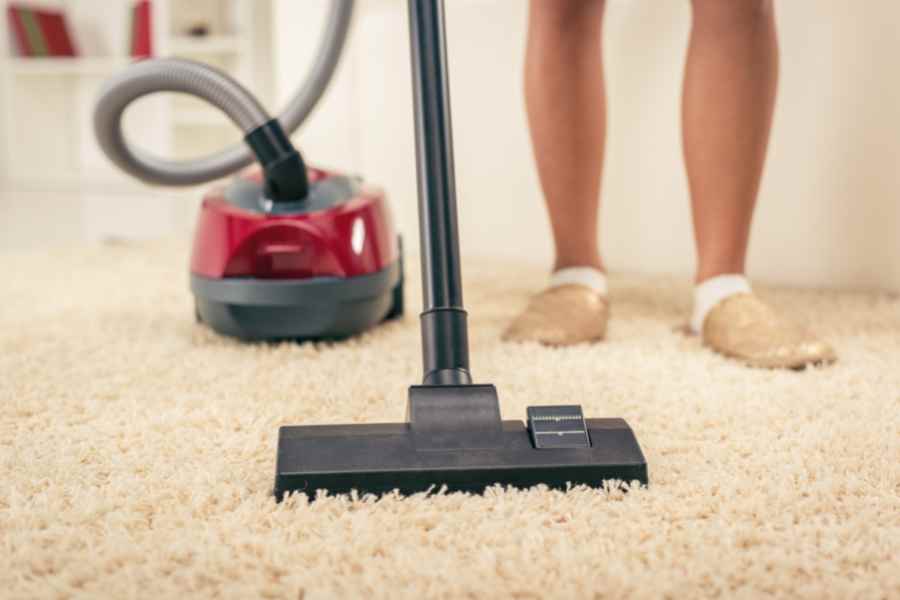
If you’re a cat owner, you’ve likely had to deal with cat litter getting outside the litter box at some point. But can you vacuum cat litter? The answer is yes, you can vacuum dry cat litter, but there are some things you should keep in mind to avoid potential damage to your vacuum cleaner.
Vacuuming dry cat litter:
- If the cat litter is dry, it’s safe to vacuum it up with a standard vacuum cleaner.
- It’s essential to vacuum slowly and use the appropriate attachment to avoid scattering the litter or clogging the vacuum cleaner.
Potential damage to vacuum cleaners:
- Damp cat litter should never be vacuumed, as it can cause damage to the vacuum cleaner’s motor and filter.
- Clumping litter should also be avoided, as it can stick to the vacuum cleaner’s filter and cause damage.
If you find cleaning cat litter with a vacuum cleaner difficult, you should deal with cat fur first. Cat fur can cause blockage once sucked in by the vacuum cleaner. Not only does the blockage affect airflow, but it also affects suction, making it impossible for the vacuum machine to pick up particles.
The litter particles will keep falling out of the hose.
If there is no noticeable blockage, you should consider investing in a new vacuum cleaner with higher suction and airflow ratings, like the WLUPEL Cordless Vacuum Cleaner.
While investing in a new high-powered vacuum cleaner might be a costly outlay, it is undoubtedly cheaper and a more long-term solution to recarpeting your home. Recarpeting your home is an expensive, time-consuming affair. You cannot recarpet your home every time your cats soil the carpets with litter.
Additionally, if you’re renting your apartment or home, chances are your lease agreement does not allow you to switch out the carpets.
However, you can consider renting a shopvac with high airflow and suction pressure. Shopvacs are designed to vacuum clean in industrial settings. Renting one makes sense if you want to deep clean the carpets in your entire house in one go, akin to general house cleaning.
Alternatives to Vacuuming: How To Get Litter Out Of Carpet Without Vacuum
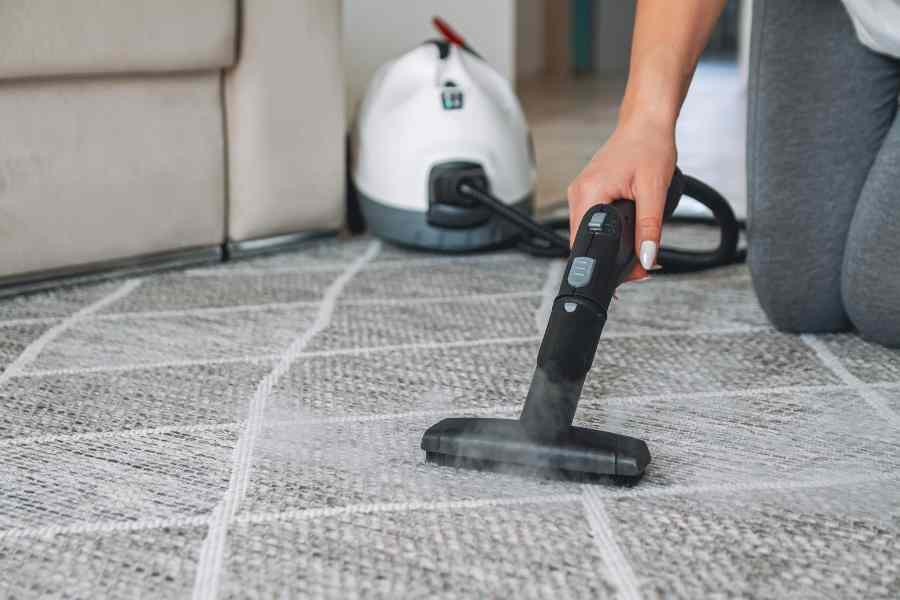
While vacuuming is the easy way out of dealing with cat litter, it is not the be-all and end-all cat litter cleaning method. There are alternative methods.
Below are some of the best ways how to get litter out of carpets without vacuuming:
- For large spills or messes, it’s best to use a dustpan and broom to sweep up the litter. After sweeping the larger chunks of cat litter, you can use sticky tape to pick up the smaller specs of litter left behind.
- For carpets with low yarn pile height (non-shaggy carpets), you can use lint rollers to pick up the little litter pieces you’re finding difficulties picking with anything else!
- Follow the manual process of picking up the litter with steam treatment. Steam treatment is especially effective when dealing with fine particles. A powerful steam cleaner can inject high-pressure steam deep into the carpet, loosen the particles and lift them away.
- A carpet shampooer is also a good complement or alternative to steam treatment. There’re plenty of cheap carpet cleaners on the market. However, if you need a heavy-duty, commercial-grade shampooer, consider renting. Go over the affected area repeatedly with the carpet cleaner until you remove all the cat litter debris.
- Finally, consider using renting a shop vacuum, which can help clean up all the cat litter in one go, as they are more powerful and better equipped to handle larger debris. Renting is an excellent alternative to buying a powerful (and typically more expensive) vacuum cleaner.
In Closing
Cat litter on carpets can be a frustrating problem, but with the right tools and techniques, it’s possible to remove it successfully. Remember to act quickly, and don’t let the litter sit on the carpet for too long. Whether you have a fresh spill or hardened litter, there’s a solution that can help. With these tips, your carpet will be clean and odor-free.
In summary, to get cat litter out of the carpet, you need to take the following steps:
- Act quickly to remove fresh litter spills.
- Use a vacuum cleaner or alternative methods to remove the litter particles.
- Apply a cleaning solution or use natural ingredients like vinegar and baking soda to remove stains or odors.
- Allow the carpet to dry completely before using the area again.
